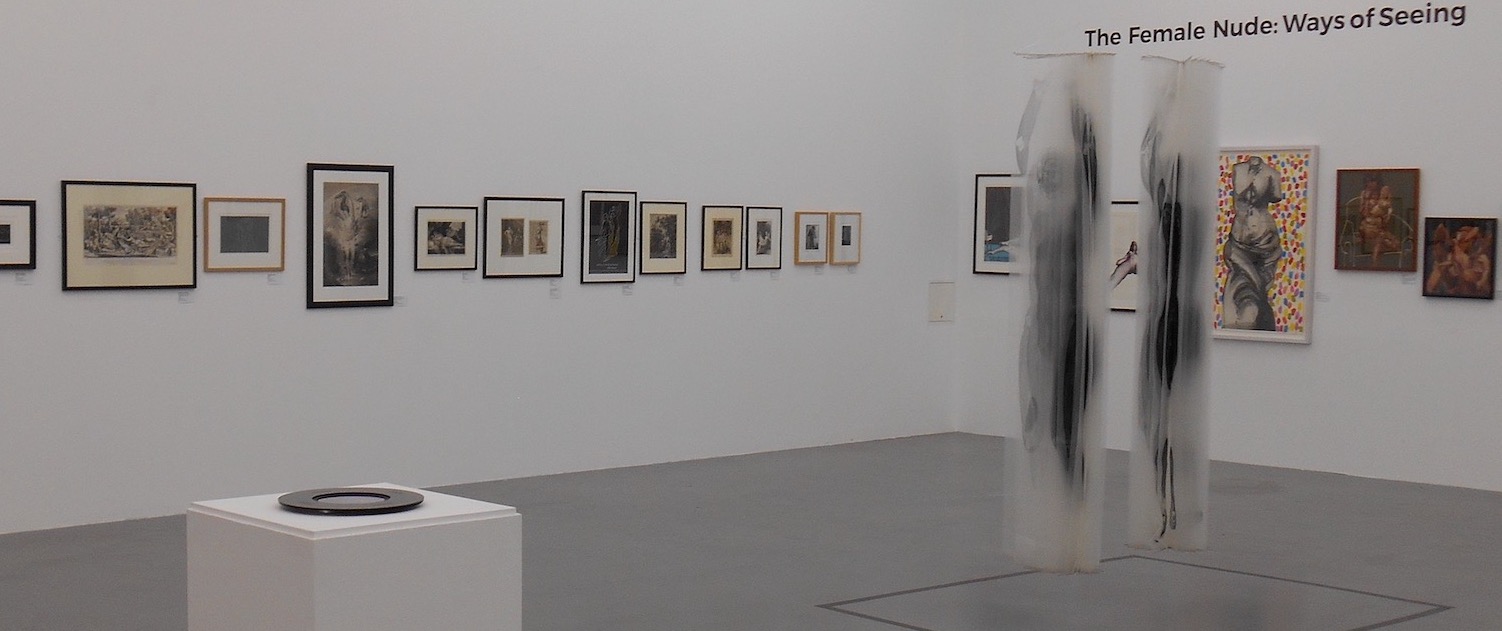Second year undergraduate Reaia Parkes offers an insightful exploration of Sonia Boyce’s drawing Missionary Position II (1985), displayed in Life Between Islands.
 Exhibition Hall in Life Between Islands
Exhibition Hall in Life Between Islands
An image of Sonia Boyce’s Missionary Position II is available here: https://www.tate.org.uk/art/artworks/boyce-missionary-position-ii-t05020
The narrative of Missionary Position II follows a young person’s reaction to authority, which we can assume is autobiographical due to the subjects’ resemblance to the artist herself. The title first and foremost represents the effects of colonialism, more specifically the heinous role of British missionaries in the colonisation of Africa and the Caribbean, on culture. The drawing shows two brightly dressed women in what appears to be a living room. One sits on the floor with eyes closed, head raised, seemingly in prayer. The other lays slightly, reaching her hand towards the first woman. Patterned wallpaper adorns the walls as well as a blue crucifix between the women, ornamental birds frame each top corner, and an orange paisley carpet expands the artist’s vivid use of pastels and colour.
The most striking feature of the drawing is its emphasis on contrasting three-dimensionality and flatness. The lack of diminishing viewpoint is accentuated by the background wallpaper. Boyce describes her paintings as a “window through which you can look to see a reflection of the same world” (Diawara and Boyce, 1992 p. 55) and the audience are welcomed as spectators. The design is modelled on palm leaves, a motif which carries itself also onto her other work Missionary Position I 1985. The interior has meaning as background items have a place in Boyce’s life. The lampstand with the bust of a black girl’s head belonged to her mother as well as the sofa. This suggests a personal and domesticated environment much like the narrative, it is personal to her and exists within her cultural memory. The Paisley carpet symbolises contextual influences of imperialism and cultural appropriation, originating in Asia but being renamed after a Scottish town. The ornamental birds are motifs in many of Boyce’s other works She Ain’t Holding Them Up, She’s Holding On (Some English Rose), 1986 and Halloween, 1985. These are also symbols of her childhood and give the tableaux an ornamental imagining, but their positioning implies a tension between the two figures below. The home represents a generation that Boyce insinuates has the inference of unconscious shrines to both religion and their heritage, “religion is centred in the home” (p. 200).
Much of Sonia Boyce’s work is inspired by an awe of the naive recounts of personal trials Frida Kahlo’s oil paintings depict. These were influenced by an awareness of the cultural consequences of colonialism in Mexico and the impact of this on her intimate politics. Boyce too speaks from an autobiographical standpoint. She explores the problems within the black experience relating to Christianity and youth. Remember we are talking about cultural intersections rather than differences. The figures, therefore, represent two parts of the whole or two sections of black femininity, the side that accepts, the side that denies and how these two struggle to coexist. A lack of communication is extended between the two figures, one with eyes closed and the other with the ear slightly distorted in the drawing technique. Boyce cleverly implies there is little discussion about religion in this community. The woman on the left is suggested to have completely submitted while the other is opposing authority laying underneath the text “positions changing”. Boyce uses herself as a model for both figures, literally dominating the space as her own story. The woman in red stands out against the largely domestic pastel background as if she opposes her surroundings. Her African dress is representative of clinging onto the diaspora and the head wrap has links to Rastafarianism and Pan-Africanism, significant in native black culture and a symbol of resistance against imposed Christianity.
Boyce also makes references to Caribbean roots in the image’s caption. The importance of oral history and lessons in Caribbean culture is acknowledged. Allowing these words to enter the art space. Patois is a spoken dialect that she has chosen to reflect visually:
Laard but look my trials nuh – | they say keep politics out of religion | and religion out of politics | but when were they ever separate? Laard give me strength
Dilip Hiro in his book Black British, White British argues the experience of slavery presents itself in the interactions of everyday black people (1973). We can infer this is responsible for the familiar structure and religious leaning of Black British people. He goes as far as to suggest “The evolution of the creole language was related directly to the mechanics of slavery”. This element again feels like a comment from Boyce on the lasting integration of colonialism in Black domestic spaces and interactions.
Extracts from Reaia Parkes’ essay.
Diawara, M. and Boyce, S., 1992. The Art of Identity. Transition, (55), p.192.
Hiro, D. (1973) Black British, White British: A History of Race Relations in Britain Paladin: Grafton; 2nd Revised edition (7 Feb. 1991)
